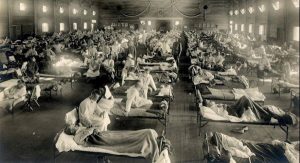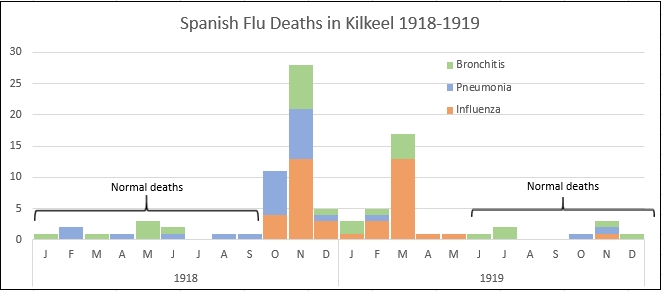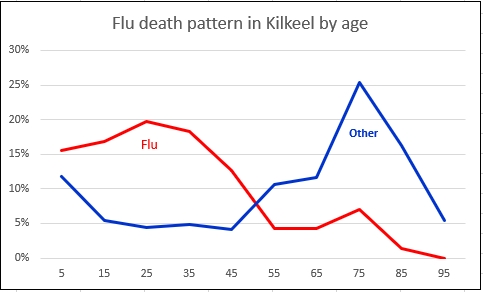Over the course of 52 months, the First World War killed around 16 million people. In twelve months, the 1918/1919 influenza pandemic killed at least 50 million, and possibly twice that number. It was the greatest medical holocaust in history, destroying more lives in 24 weeks than AIDS in 24 years, and more in a year than the Black Death killed in a century.

Why does it not loom larger in our historical awareness? One reason is official suppression of its scale. Although the earliest known outbreaks were among US troops in Kansas and near Étaples on the Western Front, wartime censorship blocked reports of the pandemic in the countries at war. Because Spain was neutral, the pandemic’s effects could be freely reported. As populations sickened and died, they heard more about the effects in Spain than in their own countries. Hence “Spanish Flu”.
In Ireland, it came in three waves. The first recorded outbreak was on the troop carrier the USS Dixie off Cobh in May. That early wave was relatively mild – those who survived acquired immunity to the two later waves. The most lethal of these came in November 1918, just as the War ended, and a last, less deadly wave arrived in spring 1919.
What does any of this have to do with genealogy? One of the great successes of recent genealogy in Ireland has been to recover, family by family, the suppressed histories of the Irishmen who fought in the First World War. Perhaps something similar needs to be done for those who died in the Spanish Flu.
The tools are already at our fingertips and perfectly adapted. The civil death records on IrishGenealogy provide detailed causes of death, day by day, district by district, and can be minutely examined using the site’s “more search options“.
 An example of what can be done by a local historian is Dermot Balson’s brilliant work on Kilkeel in Down. His two charts, based on these death records, show just how brutally the flu impacted on the area between October 1918 and March 1919, and how young adults died disproportionately.
An example of what can be done by a local historian is Dermot Balson’s brilliant work on Kilkeel in Down. His two charts, based on these death records, show just how brutally the flu impacted on the area between October 1918 and March 1919, and how young adults died disproportionately.
 A single page from the death registers of Athlone No. 1 district between December 12 and 19 1918 shows why a genealogist might also be interested. Out of the ten deaths listed, nine are influenza related. And the second last is the death of my grandfather’s first wife at the age of 30. He remarried two years later, to my grandmother.
A single page from the death registers of Athlone No. 1 district between December 12 and 19 1918 shows why a genealogist might also be interested. Out of the ten deaths listed, nine are influenza related. And the second last is the death of my grandfather’s first wife at the age of 30. He remarried two years later, to my grandmother.

My great grandmother died on 3 December 1918 at the age of 40 in Limerick City, leaving 3 young children. I always suspected the Spanish Flu and according to your article, she died during the second wave, which was the deadliest. To my knowledge, no one from the immediate family were in WW1, but living in a port city in close quarters, I would imagine the flu devasted the city. I was able to get a copy of her death certificate and the cause was listed as “bronchitis”. Maybe they didn’t know that it was the flu and only listed a symptom?
My grandmother Margaret Mulvany-Martin who was born in 1889 in EMPER, Co. Westmeath,
died in the Spanish Influenza Pandemic in the Bronx, NYC. in June of 1918.
My mom Margaret Martin was less then two years old at the time.
Rob
Hi Rob,
Do you know if it was considered an epidemic in the Bronx?
Jane
Hi Robert,
I don’t know if you’re still following this thread or whether you will get notified of a reply but I’ll take the chance.
You and I are distantly related – my grandmother shares a DNA match with one of your second cousins in England, the grandson of Margaret Mulvany-Martin’s oldest brother Michael. I was able to identify Margaret and Michael’s Mulvany grandparent’s but the records aren’t complete enough to determine whether the relationship between your Kit and my Christopher was Uncle/nephew or cousin of some kind.
Best wishes,
Tara (You’ll find me here: https://www.facebook.com/groups/CoWestmeath )
Tara
My Grandmother, Margaret Gribbin Murphy, was a WWI Army nurse. Her parents had immigrated from County Donegal and Antrim just before her birth. The Army told the family to meet the train in town because she was coming home. Much to their surprise, she was on a stretcher and deathly ill with influenza she contracted from our soldiers. The Army just said “goodbye. She recovered through the help of her Irish mother.
John, as always, you give us fascinating stuff to chew on. Thank you.
Just curious: how accurate was the diagnosis likely to be in these 1918/1919 death records?
I’m sure mostly they were correct, but you know how nowadays medics are likely to say “upper respiratory viral infection of influenza type” unless they have a lab report.
hello, I am a 1918-1919 flu historian and I and Dr Patricia Marsh were the researchers who identified those three waves from the official records. In relation to the death certification, at the time doctors were only permitted to list one cause of death from the ICD, the international standard for classifying death by cause. In the first wave, it is quite clear that many deaths were attributed to other diseases that presented in a similar way – for example bronchitis. Flu was also understood to be caused by a bacterium. There is also a tendency throughout the period for children to be diagnosed to bronchitis rather than flu, even when it is clear the disease is in their community. I have a long discussion of this in my new book, Stacking the Coffins, Influenza, War and revolution in Ireland , 1918-1918.
My great grandfather’s brother died aged 27 in February 1919 from the influenza. It’s interesting to read that it was the last wave of the virus. He was the eldest of the family and was still a bachelor. He had it for 10 days and had developed pneumonia.
My great grandmother died 1918/1919 not quite sure of the Spanish flue she was only 42 and left 9 children she lived in Ballymoat on her death certificate they put heart failure not flu.
Thank you John for another extremely interesting and very timely news letter. I became very keen to learn more a couple of years back when I discovered that two of my great uncles (two young men who were brothers) died of the ‘flu’ within 3 weeks of each other in Wexford , November 1918. So sad to see them recorded consecutively in the death register.
Stacking the Coffins – Influenza, War and Revolution in Ireland, 1918-1919 by Ida Milne is an excellent read for anyone who wants to learn more.
Clare thank you, and i’d Love to know more about these two deaths. Ida
Interesting the bronchitis and pneumonia numbers are also very high during the early and late years – one wonders if these were listed as cause of death to keep panic at bay
I don’t think so, Hilary – it’s that they are obliged to mention the immediate cause of death – and many died from pneumonia following influenza. This is under th3 ICD I mentioned elsewhere on this post. But also , death from pneumonia and bronchitis is frightfully common then, and both kill thousands each year, so they would have been the norm for the time. I calculated there were 3000 extra pneumonia deaths during the flu period.
I was interested to learn that while it killed millions the death rate from this flu was “only” about 1 in 40. The reason it killed so many was that it infected about 1/3 of the population. Combining these figures means it killed 0.5-1.0% of the affected populations. The Kilkeel figures above reflect this, with 70 dead from a population of 11,000. It could have been much more, since it didn’t affect older folk much. This seems to be attributed to their previous exposure to a similar strain that occurred back in the 1780s or thereabouts.
There is more we can tell from the death patterns in the records. I have an animation showing how the deaths started in the two population centres of Mourne, especially Kilkeel, and spread out to the rural areas.
As regards the question whether flu was diagnosed correctly, I think it was pretty accurate in Mourne, because the three causes of death that spiked during the infection period were all associated with the flu.
My grandmother’s uncle died on 29 Nov 1918 at Mater Hospital in Belfast. He died from influenza, pneumonia 4 days cardiac failure certified. He was listed as 34 but actually was 44. There are ten deaths on his ledger page; 1 died from cerebral hemorrhage and 1 from senile decay; 5 from influenza and the last 3 died from pneumonia of some form. Two of the deaths were at Mater Hospital but the other 8 were at residences.
My mother’s family always called it the Black Flu although, as far as I can make out, none of them were affected by it. My father’s family in Louth and Monaghan (who never talked about it) were very badly hit and many of them died of it.
Many who survived the flu were left weak, with a post-viral chronic illness we would now call something like M.E. My grandfather was one.
I too recently found 3 consecutive death records of the same family who died from influenza in Camolin, Co. Wexford. Mary Ann Carton (nee Ryan) aged 22 had only been married for 20 months. Her son, James Carton, was only one year old. Her sister, Mary Kate Ryan, was 6 years old. Devastating for the family.
My Uncle Patrick (Paddy) Dalton died from what my family called “The Black Flu” on 23 October 1918.
He was only 7 years of age.
Paddy’s story featured on the 100th Anniversary of his death at the Conference held in Glasnevin Cemetary Museum on 23 October 2018.
This was a very interesting and informative Conference which both historically and personally was for me an education.
My grandfather Francis Meates of Arklow Co Wicklow death certificate says he died of influenzal pneumonia after 1 week on the 29th October 1919, age 29, my grandmother also had spanish flu but she survived and gave birth to my mother in April 1919. My grandmother was left a young widow with 2 girls, my mom and her sister.
My grandfather was always called Fred so when his brother-in-law registered his death, he mistakenly put down his name as Fredrick not Francis.